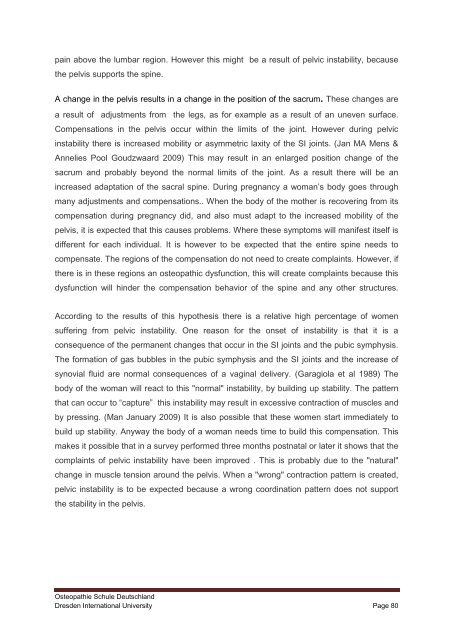Pelvic girdle pain and relevance of ASLR testing: A ... - Cindy Verheul
Pelvic girdle pain and relevance of ASLR testing: A ... - Cindy Verheul
Pelvic girdle pain and relevance of ASLR testing: A ... - Cindy Verheul
Create successful ePaper yourself
Turn your PDF publications into a flip-book with our unique Google optimized e-Paper software.
<strong>pain</strong> above the lumbar region. However this might be a result <strong>of</strong> pelvic instability, because<br />
the pelvis supports the spine.<br />
A change in the pelvis results in a change in the position <strong>of</strong> the sacrum. These changes are<br />
a result <strong>of</strong> adjustments from the legs, as for example as a result <strong>of</strong> an uneven surface.<br />
Compensations in the pelvis occur within the limits <strong>of</strong> the joint. However during pelvic<br />
instability there is increased mobility or asymmetric laxity <strong>of</strong> the SI joints. (Jan MA Mens &<br />
Annelies Pool Goudzwaard 2009) This may result in an enlarged position change <strong>of</strong> the<br />
sacrum <strong>and</strong> probably beyond the normal limits <strong>of</strong> the joint. As a result there will be an<br />
increased adaptation <strong>of</strong> the sacral spine. During pregnancy a woman’s body goes through<br />
many adjustments <strong>and</strong> compensations.. When the body <strong>of</strong> the mother is recovering from its<br />
compensation during pregnancy did, <strong>and</strong> also must adapt to the increased mobility <strong>of</strong> the<br />
pelvis, it is expected that this causes problems. Where these symptoms will manifest itself is<br />
different for each individual. It is however to be expected that the entire spine needs to<br />
compensate. The regions <strong>of</strong> the compensation do not need to create complaints. However, if<br />
there is in these regions an osteopathic dysfunction, this will create complaints because this<br />
dysfunction will hinder the compensation behavior <strong>of</strong> the spine <strong>and</strong> any other structures.<br />
According to the results <strong>of</strong> this hypothesis there is a relative high percentage <strong>of</strong> women<br />
suffering from pelvic instability. One reason for the onset <strong>of</strong> instability is that it is a<br />
consequence <strong>of</strong> the permanent changes that occur in the SI joints <strong>and</strong> the pubic symphysis.<br />
The formation <strong>of</strong> gas bubbles in the pubic symphysis <strong>and</strong> the SI joints <strong>and</strong> the increase <strong>of</strong><br />
synovial fluid are normal consequences <strong>of</strong> a vaginal delivery. (Garagiola et al 1989) The<br />
body <strong>of</strong> the woman will react to this "normal" instability, by building up stability. The pattern<br />
that can occur to “capture” this instability may result in excessive contraction <strong>of</strong> muscles <strong>and</strong><br />
by pressing. (Man January 2009) It is also possible that these women start immediately to<br />
build up stability. Anyway the body <strong>of</strong> a woman needs time to build this compensation. This<br />
makes it possible that in a survey performed three months postnatal or later it shows that the<br />
complaints <strong>of</strong> pelvic instability have been improved . This is probably due to the "natural"<br />
change in muscle tension around the pelvis. When a "wrong" contraction pattern is created,<br />
pelvic instability is to be expected because a wrong coordination pattern does not support<br />
the stability in the pelvis.<br />
Osteopathie Schule Deutschl<strong>and</strong><br />
Dresden International University Page 80


